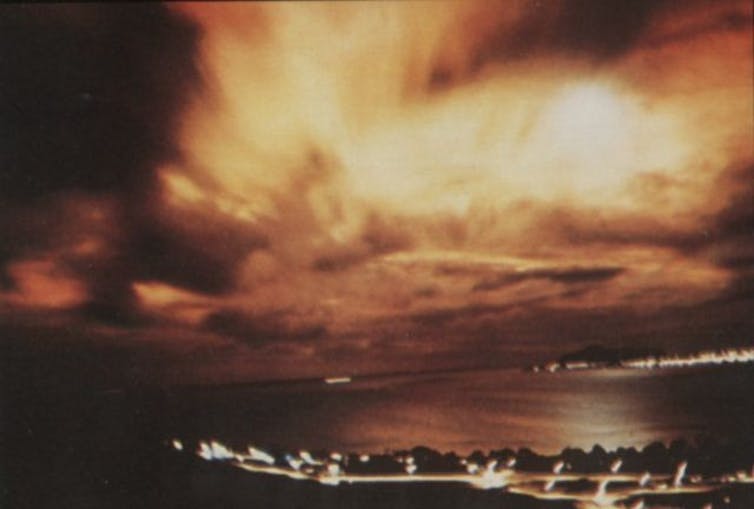The US and Japan are sponsoring a resolution for debate by the United Nations security council which – if passed – will reaffirm international commitments to the 1967 outer space treaty (OST) forbidding the deployment and use of nuclear weapons in space.
The call, headed by US ambassador Linda Thomas-Greenfield and Japan’s foreign minister Yoko Kamikawa, follows troubling reports that Russia could be developing a nuclear capable anti-satellite weapon. As an expert on space and nuclear weapons, I find these reports concerning but not surprising because nuclear anti-satellite weapons have been proposed since the cold war in the 1960s.
So far, little is known about this weapon. The White House has said it is not operational and does not pose an immediate threat. Russian president Vladmir Putin, meanwhile, stated that Moscow had no intention to pursue a weapon that puts Russia in contravention of their commitment to the OST.
The 1967 treaty is ratified by 114 nations including the US and Russia. The treaty’s Article IV, which bans the deployment of nuclear weapons in space, emerged from grave concerns about the impact of nuclear tests carried out in space by the US and Russia in the early 1960s.
The most well known is Starfish Prime, a nuclear test carried in low Earth orbit above the South Pacific in July 1962.
Nuclear explosions in space
I am a researcher at RAF Fylingdales, a ballistic missile early warning system (BMEWS) station on the north Yorkshire moors. I produced the Fylingdales Archive, which charts the station’s 60-year history of scanning space for signs of nuclear attack and tracking the increasing amount of satellites in low Earth orbit.
The performance of BMEWS electronic warfare subsystems were tested during Starfish Prime to understand resilience against blackouts caused by nuclear explosions in space.
Unlike nuclear explosions on Earth, where the energy released super-heats the atmosphere into a fireball, nuclear explosions in space release their energy as high-energy charged particles, X-rays, intense flows of neutrons and electromagnetic pulse (Emp). Emp occurs when gamma rays from the nuclear explosion strips electrons from gases in the upper atmosphere. This blinds radar, knocks out communications and destructively overloads power networks.
Starfish Prime
Emp was first observed during the Starfish Prime nuclear test. The test weapon was launched by a Thor missile from the Johnston Island in the north Pacific on July 8 1962.
Just after 11pm Honolulu time, Starfish Prime detonated 400km above Johnston Island. The thermonuclear explosion had a yield of 1.45 megatons. This is 1,000 times more powerful than the bomb dropped on Hiroshima.
The flash from the detonation could be seen across the Pacific, filling the sky with brilliant aurora displays from Hawii to New Zealand. Reports from Honolulu described the aurora as comprising blood red and pinks.
US government archive
But the pulse from the explosion was larger than anticipated. It caused electrical damage in Hawaii nearly 1,000km away by damaging electricity supply, knocking out streetlights, disrupting telephone networks and triggering burglar alarms.
The impact on satellites in low Earth orbit was profound. High-energy particles from the explosion formed radiation belts around the Earth. These were made more intense by high-energy particles, from Russian nuclear weapon tests in space above Kazakhstan, conducted in October 1962, merging with radiation from Starfish Prime.
Over the following months, the radiation damaged and destroyed one-third of satellites in Earth orbit. This included AT&T’s Telstar satellite, which was launched two days after Starfish Prime on July 10 1962. Telstar transmitted the first live transatlantic television pictures on 23 July 1962 before succumbing to Starfish Prime’s radiation the following November.
The impact of nuclear weapon testing in space galvanised the US and USSR governments to agree to the Limited Nuclear Test Ban Treaty, agreed in August 1963, and the adoption of the OST in 1967.
What would happen today?
During the Starfish Prime nuclear test there were just 22 active satellites in orbit. Today there are almost 10,000 active satellites with just over 8,000 in LEO. These support all aspects of life on Earth, including banking, healthcare, food supply, communications, navigation, climate monitoring, earth science and humanitarian aid.
The US has far more satellites in orbit than any other nation, comprising 2926 active payloads to Russia’s 167. They include Space X’s Starlink space-internet services, which with US Department of Defense, has been supporting the Ukrainian military in its combat operations against Russian forces.
Consequently, the Starlink constellation of satellites is cited as a potential target for a Russian nuclear attack in space that would use NEMP produced by a nuclear detonation to destroy the Starlink satellite constellations by frying their electronics. The residual radiation, like Telstar, would over time destroy the electronics of surviving spacecraft – rendering their orbits dangerous to other satellites.
But a nuclear attack on space infrastructure would also indiscriminately affect life on Earth. And it would have a disproportionate impact on vulnerable nations in the global south, who rely the most on space systems for optimising resources such as food security and water supply management. It would also destroy space systems of Russia’s ally China – rendering its Tiangong space-station uninhabitable by damaging onboard life-support systems.
It’s also important to note that satellites of Nato member states are protected under Article 5 of the alliance’s charter, which compels members to respond collectively to an attack on any other member state. An attack could provoke retaliation against Russian military and strategic infrastructure on Earth with conventional weapons. But it would also risk further nuclear escalation.
So deploying nuclear weapons in space is not a new concept. But Starfish Prime demonstrated that it has no military value and it presents indiscriminate dangers to life on Earth as a result of damage to satellites infrastructure.
Juliana Seuss, a space security expert with the Royal United Services Institute, stresses that such a weapon could be used when Russia has “exhausted many other options, and when the loss of allies was no longer a relevant deterrent.”
Instead, they feed a macabre political theatre of nuclear threat and innuendo, serving Russia by shoring up its fading space power. Meanwhile, in the US, these stories stokes nuclear anxiety and undermines confidence in the Biden administration.
This is why it was important for the UN to reaffirm their 50-year international commitment to the OST and mitigating wide-ranging harm from nuclear weapon in space.




